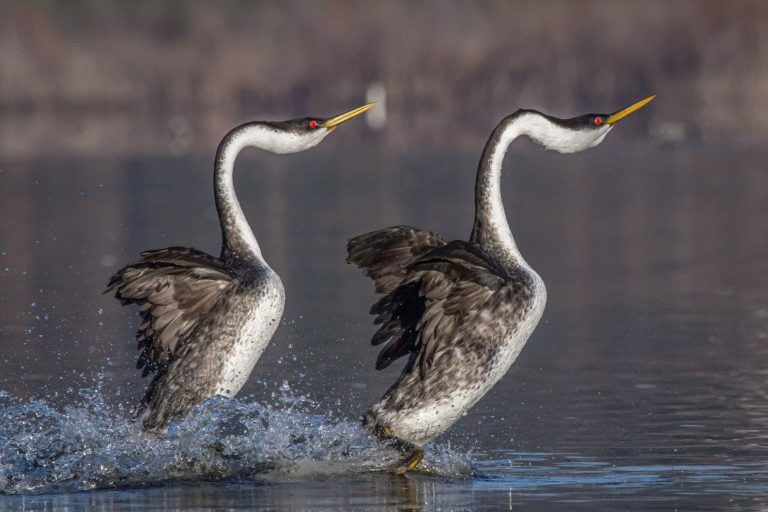By Bonnie Wood
Klamath Falls, Oregon wants to be a better town. Historically a prosperous logging center, its last several decades saw little joy, but the city is slowly evolving into a birding, hiking, and tourist destination. Calling itself “Oregon’s City of Sunshine” for its average 300 days of sun each year, it offers visitors a walking tour of its downtown and vintage buildings. More pertinent for birders, one can walk to find well-signed short hiking and birding trails easily from downtown. Eight or so hours from Olympia, I highly recommend birding Klamath Falls and its environs.
We visited on a COVID-year birding road trip this past late March, 2021. Mountain roads were still snow-closed; we stayed at lake-level altitude. The waterfowl birding was fabulous; it was too early for most migrant songbirds. Since Klamath Falls nests in high desert on the eastern side of the mountains, expect to see some resident dry-country birds one ordinarily does not see in the western Pacific Northwest.
And dry country it is. Klamath County continues to suffer a many-year profound drought, and who receives water rights continues to be a profoundly divisive conflict in the area. In 2021, the Oregon Supreme Court reaffirmed the treaty rights of the Klamath people to receive water first in order to help desperately endangered native fish populations. Irrigation water for farmers and water for refuges comes next, but water forecasts bode a grim picture. In April 2021, Interior Secretary Deb Haaland wrote, “given the dire and unprecedented water shortages that we are facing, we know that difficult decisions will need to be made in the coming days and weeks.”
The city of Klamath Falls itself sits at the southern end of Upper Klamath Lake. From this lake, the outflowing Klamath River flows into dammed Lake Ewauna and beyond. (1800s settlers called this section of the river the Link River.) We arrived at our recently built hotel on the shore of Lake Evauna mid-afternoon and stepped out the door onto the Lake Ewauna Nature Trail, a two-mile path. Paved for much of its length, the pavement ends as the trail approaches the dam and a railroad trestle to the south. Along this length were pieces of all kind of habitat: upland trees and grasses, marsh, riparian willows and shrubs, and pond. Canada Geese were abundant and noisy, protecting nests on islands in the marsh and pond. Common and Barrow’s Goldeneye, Great Egret, Bufflehead, Green-Winged Teal, Gadwall, Pied-Billed Grebe, Eared Grebe, Hooded Merganser, Common Merganser, Ring-Necked Duck, Northern Shoveler, Northern Pintail, American Wigeon, Ruddy Duck, Lesser Scaup, Double-Crested Cormorant, American Coot, Mallard, Greater Yellowlegs, Muscovy Duck: all were easily seen on the water or along the shore from this trail. Belted Kingfisher, Black Phoebe, Mourning Dove, Killdeer, House Finch, English Sparrow, Song Sparrow, Golden-Crowned Sparrow, Yellow-Rumped Warbler, Spotted Towhee, Black-Capped Chickadee, Starling, and Northern Harrier foraged. Ring-Billed Gulls patrolled above the water.
Another great hiking and birding trail is the Link Trail, which runs between Lake Ewauna and Upper Klamath Lake. See California Quail, Bewick’s Wren, Golden-Crowned Kinglet, Northern Flicker, Western Scrub Jay, Violet-Green Swallow, Tree Swallow, American Robin, Brown Creeper, White-Breasted Nuthatch, Turkey Vulture, Common Raven, Black-Billed Magpie, and Red-Tailed Hawk. At Upper Klamath Lake’s southernmost shore, at the end of the Link Trail, we saw White Pelican, Red-Breasted Merganser, Orange-Crowned Warbler, Lesser Goldfinch, Stellar’s Jay and, most exciting for us, many Western Grebes doing many synchronous mating dances on top of the water. There were Clark’s Grebes in the mix, too.
Hilltop Moore Park overlooks Upper Klamath Lake and offers myriad walking trails. In this drier high-desert habitat, Mountain Chickadee and Juniper Titmouse were special and unusual sightings for us Western Washingtonians.
Klamath birders told us definitely not to miss a new wetlands preserve a short distance north of Klamath Falls, the Wood River Wetlands. Created to store and manage irrigation water, this marvelous, peaceful, bird-filled place offered Greater White-Fronted Goose, Snow Goose, Trumpeter Swan, Canvasback Duck, Cinnamon Teal, Sandhill Crane, Canada Goose galore, Cliff Swallow, Marsh Wren, Dunlin, White-Faced Ibis, Cedar Waxwing, White-Crowned Sparrow, Chipping Sparrow, Eurasian-Collared Dove, Osprey, Oregon Junco, Kestrel, Barn Swallow, Northern Mockingbird, Great Horned Owl, Northern Shrike, Loggerhead Shrike, Downy Woodpecker, Western Meadowlark, and, of course, other afore-mentioned waterfowl and land birds.
Enough with the lists of birds: Klamath Falls, Oregon’s fame as a birding hotspot is well-deserved and worth the trip south.








